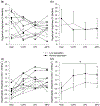Peripheral chemoresponsiveness during exercise in male athletes with exercise-induced arterial hypoxaemia
- PMID: 32857874
- PMCID: PMC8232077
- DOI: 10.1113/EP088639
Peripheral chemoresponsiveness during exercise in male athletes with exercise-induced arterial hypoxaemia
Abstract
New findings: What is the central question of this study? Do highly trained male endurance athletes who develop exercise-induced arterial hypoxaemia (EIAH) demonstrate reduced peripheral chemoresponsiveness during exercise? What is the main finding and its importance? Those with the lowest arterial saturation during exercise have a smaller ventilatory response to hypercapnia during exercise. There was no significant relationship between the hyperoxic ventilatory response and EIAH. The findings suggest that peripheral chemoresponsiveness to hypercapnia during exercise could play a role in the development of EIAH. The findings improve our understanding of the mechanisms that contribute to EIAH.
Abstract: Exercise-induced arterial hypoxaemia (EIAH) is characterized by a decrease in arterial oxygen tension and/or saturation during whole-body exercise, which may in part result from inadequate alveolar ventilation. However, the role of peripheral chemoresponsiveness in the development of EIAH is not well established. We hypothesized that those with the most severe EIAH would have an attenuated ventilatory response to hyperoxia and hypercapnia during exercise. To evaluate this, on separate days, we measured ventilatory sensitivity to hyperoxia and separately hypercapnia at rest and during three different exercise intensities (25, 50% of and ventilatory threshold (∼67% of )) in 12 males cyclists ( = 66.6 ± 4.7 ml kg-1 min-1 ). Subjects were divided into two groups based on their end-exercise arterial oxygen saturation (ear oximetry, ): a normal oxyhaemoglobin saturation group (NOS, = 93.4 ± 0.4%, n = 5) and a low oxyhaemoglobin saturation group (LOS, = 89.9 ± 0.9%, n = 7). There was no difference in (66.4 ± 2.9 vs. 66.8 ± 6.0 ml kg-1 min-1 , respectively, P = 0.9), peak ventilation during maximal exercise (182 ± 15 vs. 197 ± 32 l min-1 , respectively, P = 0.36) or ventilatory response to hyperoxia (P = 0.98) at any exercise intensity between NOS and LOS groups. However, those in the LOS group had a significantly lower ventilatory response to hypercapnia (P = 0.004, (η2 = 0.18). There was also a significant relationship between the mean hypercapnic response and end-exercise (r = 0.75, P = 0.009) but not between the mean hyperoxic response and end-exercise (r = 0.21, P = 0.51). A blunted hypercapnic ventilatory response may contribute to EIAH in highly trained men due to a failure to increase ventilation sufficiently to offset exercise-induced gas exchange impairments.
Keywords: carotid chemosensor; hypercapnia; hypoxia; ventilation.
© 2020 The Authors. Experimental Physiology © 2020 The Physiological Society.
Conflict of interest statement
COMPETING INTERESTS
None.
Figures



References
-
- Bain AR, Drvis I, Dujic Z, MacLeod DB, & Ainslie PN (2018). Physiology of static breath holding in elite apneists. Experimental Physiology, 103, 635–651. - PubMed
-
- Byrne-Quinn E, Weil J,V, Sodal IE, Filley GF, & Grover RF (1971). Ventilatory control in the athlete. Journal of Applied Physiology, 30, 91–98. - PubMed
-
- Dejours P (1962). Chemoreflexes in breathing. Physiological Reviews, 42, 335–358. - PubMed
-
- Dempsey JA (1986). Is the lung built for exercise? Medicine and Science in Sports and Exercise, 18, 143–155. - PubMed
Publication types
MeSH terms
Substances
Grants and funding
LinkOut - more resources
Full Text Sources
Medical
Miscellaneous

